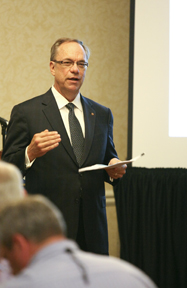Influence Through Design
In his 1907 work, “The Seven Lamps of Architecture,” John Ruskin entreaties the architectural community to embrace the essential concept that, “All architecture proposes an effect on the human mind, not merely a service to the human frame.”
Think about it! The room you are in right now by virtue of its size, color, light, and air quality is having a unique effect on your mind as you ponder Ruskin’s statement.
For this reason, the architectural community should also feel responsible for positively influencing the direction of the corrections built environment. It’s not only good for business but acknowledging the need and the challenge provides a unique opportunity to influence how architecture can make an effect on the potentially rehabilitated human mind of inmates, and the conditions in which staff much constantly operate.

Three organizations that provide a significant opportunity to influence the built correctional environment are the American Institute of Architects’ Academy of Architecture for Justice, the American Correctional Association’s Facility Design Committee and the ACA’s standards committee. For those who create, build, or use the correctional environment, this article will address why I have found these organizations so important to all stakeholders in corrections, and how we as architects can get involved and have an impact.
In correctional facilities, environmental effects — size, color, light, and air quality — have been influenced by multiple sources. For over 25 years, excellence in correctional, law enforcement, and courts projects has been promoted through the AIA/AAJ’s Justice Facility Review, while the resources assembled by the ACA’s standards committee evaluate and recommend influencing elements ranging from security to sustainability. Each of these organizations welcomes your participation. Each organization depends on your involvement to grow and, now more than ever, to even survive.
The AAJ has had hundreds of justice architectural stakeholder members throughout its 30-plus year history. The AIA/AAJ is led by an advisory group committee that welcomes participation from architects and conducts an annual conference that includes architects, builders, vendors and clients.
The annual conference historically focuses on three tracks: law enforcement, corrections and courts. Each of these tracks has sessions with panels made up of justice architectural stakeholders.
In addition, the advisory group produces the aforementioned Justice Facility Review. Published projects are selected by a jury that is made up of both architects and users that are often project clients, such as sheriffs, state corrections administrators, jail commanders, and judges.
Projects selected for annual publication are celebrated at the Justice Facility Review banquet, always at a venue of significance in the city of the AAJ’s Justice Design conference. The awarding of certificates is not only an opportunity to recognize projects that are influencing the built environment, but also the users, clients, architects, builders, and vendors that have been the influencers.
If the AIA/AAJ is where you wish to get involved, the current advisory group chairman is Herb Roth, FAIA.
The chairman of the AIA/AAJ 7th International Conference on Justice Design, in Boston from November 17-20, is Maurice Finegold, FAIA.
The American Correctional Association facility design committee is made up of 30 members who are correctional architects, planners, builders, vendors, and administrators. Membership is by a request to the committee’s chairman and approval by the ACA. The facility design committee meets on Sunday afternoon before the ACA winter and summer conferences. The committee applies its correctional industry knowledge to issues of influence from product developments to codes and standards. Often, the facilities design committee is called on by the ACA standards committee to research and recommend new standards, or modifications to existing standards.
The facility design committee is chaired by Ed Spooner, AIA.
The ACA standards committee is a 20-person group and appointed by the ACA president and chair of the committee. Interested parties should be directed to Kathy Black-Dennis, director of standards, accreditation, and professional development.
If an appointment is not desired or possible, there are still two excellent ways to participate and have influence on the standards set forth by this committee.
First, approximately 75 days prior to each ACA conference, new standards can be proposed or comments can be made on-line to existing standards by any ACA member.
Secondly, public comments are welcome prior to the start of each standards committee meeting. The standards committee meets the Friday before the start of both the winter and summer ACA conferences. Public comments range from research feedback from the facility design committee to field comments on proposed standards.
Participation on a committee or speaking during the public comment forum are meaningful ways to influence the decision-makers of correctional standards.
Correctional environments must address people in an extreme state of mental vulnerability. The correctional staffs that work in these environments know this fact better than anyone —even better than John Ruskin.
As the professionals that so many depend on for creating safe, secure, and humane facilities, we need to step-up our commitments to contribute our expertise and influence the decisions that affect so many.
Ron Budzinski is senior principal for criminal justice architecture at PSA-Dewberry. He is a member of the American Correctional Association’s Facility Design Committee.
Get Involved
AIA/AAJ Advisory Group
Herb Roth, FAIA, chairman
hroth@rothsheppard.com
AIA/AAJ Seventh International
Conference on Justice Design
Maurice Finegold, FAIA, chairman
mnf@faainc.com
ACA Facility Design Committee
Ed Spooner, AIA, chairman
espooner@geogroup.com
ACA Standards Committee
Kathy Black-Dennis, director
kathyd@aca.org
